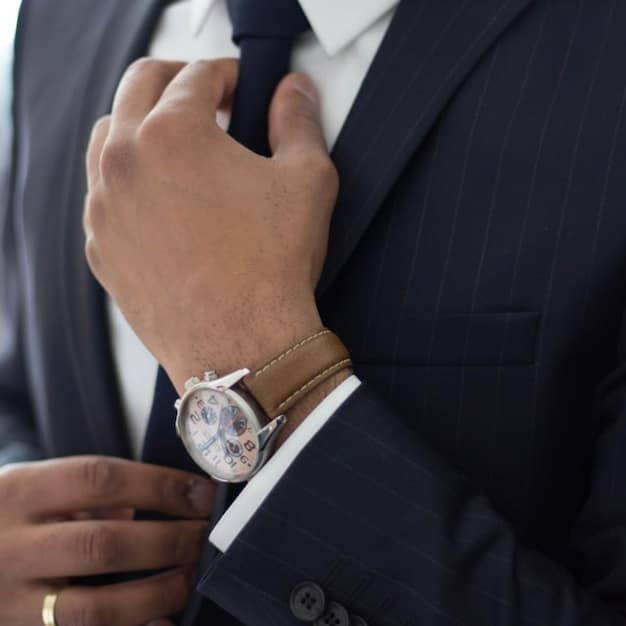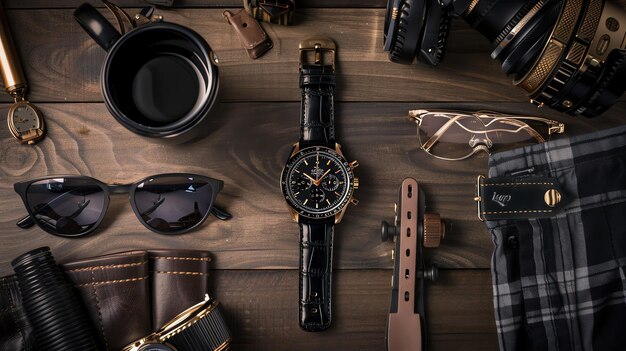Men’s Watch Guide: Choosing the Right Watch for Every Occasion

Choosing the correct watch involves understanding the event’s formality, your personal style, and the watch’s features, ensuring a cohesive and appropriate accessory for any male’s ensemble.
For men, a watch is far more than a mere time-telling device; it’s a statement of personal style, a reflection of occasion, and a subtle nod to sophistication. Understanding How to Choose the Right Watch for Every Occasion: A Man’s Guide is essential for curating a versatile wardrobe that speaks volumes without a single word. This guide aims to demystify the art of watch selection, ensuring you’re always impeccably accessorized.
The Fundamentals of Watch Selection: Beyond Telling Time
Watches have evolved from simple utility to intricate pieces of art that symbolize status, taste, and personal history. Selecting a watch isn’t just about what looks good; it’s about understanding the subtle cues it sends and ensuring it aligns with the context. This foundational knowledge empowers you to make informed decisions that enhance your overall presentation.
Understanding Watch Types and Their Purpose
Each watch type serves a distinct purpose, designed with specific functionalities and aesthetics in mind. Recognizing these differences is your first step towards building a versatile watch collection. From the ruggedness of a dive watch to the sleek elegance of a dress watch, each has its moment to shine.
- Dress Watches: Characterized by their slim profile, minimalist dials, and often leather straps, these are designed for formal occasions. Think understated elegance.
- Sport Watches: Built for durability and functionality, often featuring chronographs, water resistance, and robust cases. Ideal for active lifestyles.
- Field Watches: Originating from military use, they are known for their legibility, ruggedness, and utilitarian design. Perfect for casual, outdoor adventures.
- Diver Watches: Recognizable by their rotating bezels and high water resistance, these are robust and functional, often worn as a stylish statement piece.
Beyond these common categories, there are also aviator watches with their large, easy-to-read dials, often with complications like GMT functions for tracking multiple time zones. Knowing which type fits which scenario is crucial. A dress watch at a casual barbecue might feel out of place, just as a large, brightly colored sports watch in a boardroom could be distracting. The key is in appropriate harmonization. When considering aesthetics, the material of the watch case and strap also plays a significant role. Stainless steel offers durability and a classic look, while precious metals like gold or platinum elevate the watch to a luxury item, suitable for the most formal events.
Consider the interplay of form and function. While a sports watch might offer a multitude of features, its primary role is to be reliable and readable under demanding conditions. A dress watch, on the other hand, prioritizes aesthetic refinement and discretion. These distinctions are not rigid rules but rather guidelines that help frame your choices. The best watch often flawlessly blends into its environment, complementing rather than dominating your attire.
Deciphering Formality: Matching Your Watch to the Event’s Tone
The cornerstone of appropriate watch selection lies in understanding the formality of the occasion. Just as you wouldn’t wear a tuxedo to a beach party, your watch choice should align with the social expectations of the event. This sensitivity to context elevates your style from merely acceptable to truly refined.
Formal Affairs: Black Tie and Business Elegance
When attending black-tie events, weddings, or high-stakes business meetings, your watch should exude understated sophistication. The goal is to complement your attire without drawing excessive attention. A classic dress watch is almost always the correct choice, prioritizing elegance over utility.
- Case Material: Opt for precious metals like gold, rose gold, or platinum. Stainless steel can also be appropriate if highly polished and slim.
- Dial: Clean, uncluttered dials are preferred. White, silver, or black faces with simple indices or Roman numerals are ideal.
- Strap: A high-quality leather strap (black or dark brown) is traditional and always appropriate. Avoid metal bracelets for formal events.
- Size: Keep the watch slim enough to slide discreetly under a shirt cuff. Overly large watches can appear clunky and out of place.
For business events, while a dress watch remains a top choice, certain professional settings might allow for a slightly more robust option like a sophisticated stainless steel watch with a minimalist design. The key is to maintain a sense of gravitas and professionalism. This means avoiding anything overtly flashy or sporty. The watch should be an extension of your professional persona, reliable and refined. The elegance of a formal watch comes not from its complexity, but from its simplicity and the quality of its materials and craftsmanship. It’s a statement of mature taste and an appreciation for timeless design.
Casual Chic: Watches for Everyday Wear and Relaxed Settings
Navigating casual settings with style means finding watches that are versatile, comfortable, and reflect a laid-back yet discerning aesthetic. This is where personal expression can truly shine, allowing for a broader range of styles and functionalities. The right casual watch seamlessly integrates into your daily life, offering both utility and a touch of character.
Weekend Adventures and Leisure Activities
For weekend outings, sporting events, or simply running errands, comfort and durability often take precedence. This is when sport watches, field watches, and even certain diving watches come into their own. They are built to withstand the rigors of an active lifestyle while still looking stylish.
- Sporty Diver: A robust diver’s watch, perhaps with a rubber or NATO strap, offers both functionality and a relaxed, adventurous look. Its water resistance makes it practical for various activities.
- Field Watch: With its military heritage, a field watch is perfect for outdoor pursuits. Its clear, legible dial and rugged build are ideal for hiking, camping, or a casual day out.
- Chronograph: A chronograph, particularly in stainless steel or with a sporty leather strap, can add a dynamic touch to a casual outfit, perfect for tracking time during activities or simply for its aesthetic appeal.
When choosing a watch for casual wear, consider personalizing it with different straps. A metal bracelet offers a slightly more polished casual look, while a nylon NATO strap or a canvas strap can inject color and a more relaxed vibe. Furthermore, the size of the watch can be larger than what’s acceptable for formal occasions, allowing for bigger dials and more prominent features. This is your opportunity to experiment with colors, textures, and even smart functionalities if you opt for a smartwatch that blends with your casual style. The goal is to find a watch that feels right for you, reflecting your personality without being overly flashy or inappropriate for the setting.

Business Casual and Smart Casual: Striking the Balance
The lines between business casual and smart casual can sometimes feel blurry, but your watch choice is a powerful tool to navigate these distinctions with confidence. These categories offer more flexibility than formal wear but still demand a thoughtful approach to avoid looking underdressed or overly formal. It’s about finding that sweet spot where professionalism meets personal style.
Navigating the Modern Workspace and Social Gatherings
For roles that are less rigid than traditional corporate environments, or for social events that require a polished yet relaxed look, a versatile watch is key. This often involves watches that bridge the gap between formal dress watches and robust sports models.
- Versatile Dress Casual: A watch with a clean, classic dial but perhaps a slightly larger case or a more durable strap material like a quality brown leather or a Milanese mesh bracelet.
- Sophisticated Chronograph: A chronograph in a refined finish, maybe with a smaller case size and a well-crafted leather strap, can add a touch of sporty elegance without being overpowering.
- Pilot Watch: With their often distinctive large numerals and clear dials, pilot watches can offer a unique and sophisticated twist to a business casual ensemble, especially when paired with a good leather strap.
The key here is balance. Avoid watches that are too flashy or those designed purely for extreme sports. Materials like stainless steel, brushed finishes, and classic leather straps are often excellent choices. You might also consider watches with complications that are useful but not visually overwhelming, such as a date window or a subtle moon phase indicator. The watch should feel at home whether you’re in a creative office environment, at an informal client lunch, or enjoying a smart casual dinner out. It’s about demonstrating attention to detail and an understanding of refined aesthetics without appearing stuffy. The modern business casual environment values a blend of comfort and competence, and your watch should echo this sentiment.
Material Matters: Case, Strap, and Dial Considerations
The materials used in a watch profoundly impact its aesthetics, durability, and suitability for different occasions. Understanding these elements is vital to choosing a timepiece that not only looks good but also performs well and withstands the test of time, both literally and stylistically. Each component plays a crucial role in the watch’s overall character.
Case Materials: Durability, Aesthetics, and Weight
The watch case is its armor, protecting the delicate internal mechanisms. Its material dictates much about the watch’s feel and appearance.
Stainless Steel: The most common choice, offering excellent durability, corrosion resistance, and a versatile aesthetic that can be dressed up or down. It’s a workhorse material, suitable for almost any type of watch.
Precious Metals (Gold, Platinum, Silver): Reserved for luxury and formal watches, these materials convey prestige and elegance. However, they are softer and more prone to scratches than steel, making them less ideal for rugged use.
Titanium: Lighter and stronger than stainless steel, titanium is hypoallergenic and highly corrosion-resistant. Its darker, sometimes duller, appearance gives it a modern, utilitarian edge, often found in sport or tool watches.
Ceramic: Extremely scratch-resistant and lightweight, ceramic offers a sleek, modern look. It’s often used in high-end fashion and sport watches, though it can be brittle if subjected to severe impact.
Bronze: Develops a unique patina over time, giving each watch a distinctive, vintage character. Popular in dive watches for its aesthetic aging process.
Strap Choices: Comfort, Style, and Functionality
The strap is not just about keeping the watch on your wrist; it’s a major style determinant and comfort factor.
- Leather Straps: Classical and formal, available in various finishes like alligator, calfskin, or cordovan. Ideal for dress watches and business casual. Color matching with your belt and shoes is a style fundamental.
- Metal Bracelets: Durable and robust, often made of stainless steel, but also available in titanium or gold. They offer a more substantial feel and a dressier casual look. Styles include oyster, jubilee, and mesh.
- Rubber Straps: Excellent for sport and dive watches due to their water resistance, comfort, and durability. They offer a modern, active aesthetic.
- NATO/Zulu Straps: Made from nylon, these are highly durable, comfortable, and often seen on field and casual watches. They allow for easy customization and offer a rugged, utilitarian vibe.
- Canvas Straps: Similar to NATO in their casual appeal but often thicker and with a more textured feel, ideal for a vintage or field watch look.
Dial Aesthetics: Legibility, Complications, and Design
The dial is the face of your watch, conveying information and aesthetic appeal.
Legibility: Essential for all watches, but especially for sport or aviator watches where quick, clear readings are vital. Large numerals, luminous hands, and anti-reflective coatings improve readability.
Complications: Features beyond telling time, such as date windows, chronographs, moon phases, or GMT functions. While adding functionality, they can also contribute to visual clutter if not artfully integrated.
Colors and Textures: Dial colors ranging from classic black, white, and silver to more adventurous blues, greens, or even patterned dials. Textures like sunburst, matte, or guilloché add depth and character. The choice should reflect personal taste and the intended occasion.
Understanding these material considerations allows for a more nuanced approach to watch selection, ensuring that your timepiece not only looks the part but also meets the practical demands of your lifestyle and chosen occasion. It’s about selecting a watch that feels right on your wrist and resonates with your personal narrative.
Maintenance and Care: Preserving Your Timepiece Investment
A watch is often a significant investment, both financially and sentimentally. Proper maintenance and care are paramount to preserving its functionality, aesthetic appeal, and longevity. Neglecting these aspects can lead to costly repairs or premature wear, diminishing the value and enjoyment of your timepiece. A well-maintained watch tells a story of care and appreciation.
Routine Habits for Longevity
Implementing a few simple habits can go a long way in ensuring your watch remains in pristine condition, ready for any occasion. These practices minimize daily wear and tear and protect against common damaging elements.
- Regular Cleaning: Gently wipe your watch down with a soft, dry cloth after each wear to remove oils, sweat, and dirt. For water-resistant watches, a soft brush and mild soap can be used, ensuring to rinse thoroughly and dry immediately.
- Avoid Harsh Chemicals: Perfumes, colognes, lotions, and cleaning agents can damage watch components, particularly gaskets, which affect water resistance, and metal finishes. Apply these products before putting on your watch.
- Temperature Extremes: Extreme heat or cold can affect the lubrication and accuracy of mechanical movements. Avoid leaving your watch in direct sunlight, hot cars, or extremely cold environments.
- Magnetism: Magnetic fields from phones, speakers, and laptops can magnetize a mechanical watch’s hairspring, causing it to run fast. If you suspect magnetization, a watchmaker can demagnetize it.
- Water Resistance Check: If your watch is water-resistant, have its seals checked every 1-2 years by a professional watchmaker, especially if exposed to water frequently.
Professional Servicing: When and Why it Matters
Even with diligent home care, watches require professional attention. Mechanical watches, in particular, are complex machines that benefit from periodic expert service. Skipping these appointments can lead to significant issues down the line.
Intervals: Most manufacturers recommend servicing mechanical watches every 3 to 5 years. Quartz watches typically require battery replacement every 2-5 years, often a good time for a general check-up. These intervals can vary based on the specific movement and how often the watch is worn.
What Servicing Includes: A full service usually involves disassembling the movement, cleaning each component, inspecting for wear, replacing worn parts, re-lubricating, reassembling, regulating for accuracy, cleaning and polishing the case and bracelet, and a thorough water resistance test.
Benefits: Regular servicing ensures the movement operates optimally, maintaining accuracy and preventing premature wear of components. It also helps detect potential issues before they become major problems, ultimately extending the life of your watch.
Choosing a reputable, certified watchmaker for servicing is crucial. They possess the specialized tools, knowledge, and genuine parts required to properly care for your timepiece. Thinking of your watch as an investment that requires routine care will ensure it remains a steadfast and stylish companion for years to come, ready to accompany you to every occasion life throws your way.
Building a Versatile Watch Wardrobe: Beyond a Single Timepiece
While one perfectly chosen watch can carry you through many situations, true mastery of personal style often involves a small, curated collection. A versatile watch wardrobe empowers you to accessorize with precision, ensuring you always have the ideal timepiece to complement your attire and the occasion’s demands. It’s about being prepared, stylishly.
Starting Small: The Essential Two or Three
You don’t need dozens of watches to be well-equipped. A strategic selection of two or three watches can cover a wide spectrum of occasions, providing both functionality and flair. This minimalist approach focuses on coverage rather than quantity.
- The Dress Watch: A classic, slim-profile watch with a leather strap. This is indispensable for formal events, business meetings, and any occasion requiring refined elegance.
- The Versatile Everyday Watch: A robust, high-quality stainless steel watch, perhaps a good diver or a well-designed field watch, capable of transitioning from smart casual to truly casual settings. A metal bracelet offers versatility, and you can always swap it for a leather or NATO strap.
- The Sport/Beater Watch: This could be a G-Shock, a digital watch, or an affordable, highly durable analog watch. It’s for activities where you wouldn’t want to risk your nicer pieces – gym, yard work, or adventurous travel.
This trio ensures you’re prepared for everything from a black-tie gala to a rugged outdoor adventure. It’s about selecting watches that fulfill distinct roles and complement different facets of your lifestyle. The specific styles within these categories can be adapted to your personal taste, but the functional archetypes remain consistent.
Expanding Your Collection: Adding Specificity and Flair
Once you have the essentials covered, you can begin to expand your collection based on your interests, lifestyle, and aesthetic preferences. This is where you can explore more niche styles or experiment with bolder statements.
Aviator Watch: If you appreciate vintage aesthetics or travel frequently, a pilot watch with its large, legible dial and potential GMT function can be a stylish and practical addition.
Chronograph with Character: Beyond a simple everyday chronograph, consider one with a unique dial color, a specific racing heritage, or an intriguing movement for when you want to make a statement.
Vintage Piece: A classic vintage watch can add immense character and history to your collection. This requires careful research into reputable sellers and an appreciation for the charm of older timepieces.
Fashion Watch: While often overlooked by purists, a well-designed fashion watch from a reputable brand can offer a specific aesthetic or color not found in traditional watchmaking, perfect for trend-conscious outfits.
Smartwatch: For tech enthusiasts, a smartwatch seamlessly integrates with your digital life, offering notifications, fitness tracking, and customizable faces. Modern smartwatches often boast sophisticated designs that can rival traditional timepieces for casual and even some business casual settings.
The beauty of building a watch wardrobe lies in its personal journey. Each timepiece should resonate with you, reflecting a part of your style narrative. It’s not about accumulation, but about curation—selecting watches that bring joy, serve a purpose, and ultimately, enhance your ability to confidently approach every occasion.

Common Pitfalls and How to Avoid Them
Navigating the world of watches can be exhilarating, but it’s also fraught with potential missteps that can diminish your style or lead to buyer’s remorse. Being aware of these common pitfalls can help you make more astute choices, ensuring your watch collection truly serves your needs and enhances your personal aesthetic.
Overlooking Fit and Comfort
One of the most overlooked aspects is how a watch actually feels on your wrist. A watch that is too large, too heavy, or constantly snagging on your clothing will likely end up unworn, regardless of its appearance.
- Wrist Size: Consider your wrist circumference. Men with slender wrists might find oversized watches overwhelming, while those with larger wrists can comfortably wear bigger cases. Rule of thumb: the lugs (where the strap connects) shouldn’t extend beyond the edges of your wrist.
- Weight Distribution: A heavy watch can become uncomfortable over long periods. Evaluate the balance between the case and the strap.
- Strap Material and Adjustability: Ensure the strap material is comfortable against your skin and that it can be easily adjusted to a snug but not tight fit. A properly fitted watch should not slide excessively up or down your arm.
Sacrificing Quality for Trends
It’s tempting to chase the latest trends, but often, these pieces offer fleeting appeal and questionable durability. Investing in quality over transient fashion is a more sustainable and ultimately more stylish approach.
Focus on Craftsmanship: Prioritize watches from reputable brands known for their heritage, quality movements, and robust construction. These watches are built to last and retain their appeal.
Timeless Design: Opt for classic designs that endure beyond seasonal fads. A watch with timeless aesthetics will serve you well for years, becoming a reliable companion rather than a passing fancy.
Movement Type: While quartz watches offer accuracy and convenience, mechanical watches often represent a higher level of craftsmanship and engineering, appealing to those who appreciate traditional watchmaking. Choose based on your priorities rather than solely on cost or superficial trends.
Ignoring the Power of Versatility
Unless you aim for a vast collection, each watch should offer some degree of versatility. A watch that can only be worn in one very specific context might not be the most practical first or second purchase.
Strap Swapping: Many watches allow for easy strap changes, instantly transforming their character. A watch on a metal bracelet can become more casual with a leather strap, or sporty with a NATO. This makes one watch truly adaptable.
Color Coordination: While tempting to buy watches in every color, start with versatile neutrals for the dial and strap (black, white, silver, brown, navy) as they will pair well with most outfits. Add bolder colors as your collection grows and your specific needs emerge.
By sidestepping these common pitfalls, you can build a thoughtful and effective watch collection that not only reflects your personal style but also serves you reliably for every occasion. It’s about making intelligent, informed choices that ultimately enhance your presence.
| Key Aspect | Brief Description |
|---|---|
| 🤵 Formality Alignment | Match watch type (dress, sport, casual) to event’s tone. |
| 🛠️ Material Choices | Consider case (steel, gold, titanium), strap (leather, metal, rubber) for durability and style. |
| 📏 Fit & Comfort | Ensure watch size and strap fit your wrist comfortably; avoid bulkiness. |
| 🔄 Versatile Collection | Build a small, curated wardrobe (dress, everyday, sport) for diverse scenarios. |
Frequently Asked Questions About Watch Selection
A dress watch is typically slim, minimalist, and designed for formal events. It usually features a simple dial, often thin hands, and is almost always paired with a leather strap. Its primary function is to discreetly complement formal attire without drawing excessive attention or appearing overly utilitarian.
While traditionalists might advise against it, wearing a classic, understated diver’s watch with a suit has become acceptable in modern business casual settings. However, for truly formal or black-tie occasions, a dedicated dress watch is always the more appropriate and stylish choice to maintain elegance and respect for the event’s formality.
A well-rounded collection typically includes three essential watches: a formal dress watch, a versatile everyday watch (like a quality stainless steel sport semi-dress or field watch), and a durable, more casual watch for active use. This trio provides sufficient coverage for most social and professional scenarios.
Yes, for formal and business attire, it’s generally considered a sign of refined style to match your leather watch strap’s color to your leather belt and shoes. This creates a cohesive and polished look. For casual outfits or metal bracelets, this rule is less rigid, allowing for more personal expression.
The ideal watch size depends on your wrist circumference. A general guideline is that the watch lugs should not extend beyond the edges of your wrist. For most men, case sizes between 38mm and 42mm are versatile. Larger watches suit bigger wrists, while smaller wrists benefit from more modest diameters.
Conclusion
Mastering the art of choosing the right watch for every occasion is a nuanced skill that significantly enhances a man’s personal style and confidence. Beyond merely telling time, a watch reflects an understanding of formality, an appreciation for craftsmanship, and a keen eye for detail. By considering the occasion, materials, fit, and building a versatile collection, you ensure that your timepiece always acts as a perfect extension of your attire, speaking volumes about your taste and preparedness. With thoughtful selection and diligent care, your watches will not only serve you well but also become cherished companions throughout life’s many moments.





